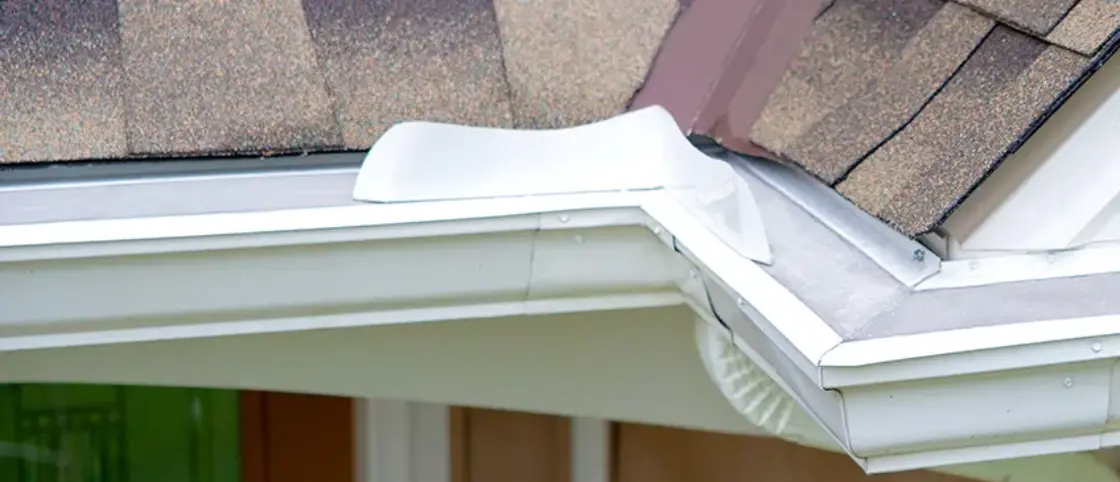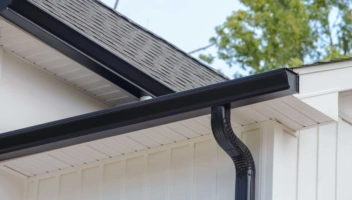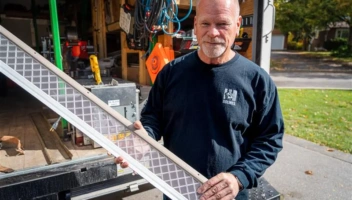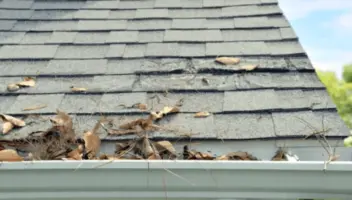What Are Gutter Splash Guards?

Gutters are meant to help protect your home and foundation from water damage, yet that can be difficult to do without gutter splash guards. That’s because gutter splash guards help prevent water from overshooting your gutters.
They are necessary since the amount of water that flows from a roof valley into a gutter is far more significant than the amount of water that flows into the gutter from other sections of your roof.
In this article:
- What Do Gutter Splash Guards Do?
- Benefits of Splash Guards
- Types of Gutter Splash Guards
- Installation Tips (DIY or Professional)
- Frequently Asked Questions
What Do Gutter Splash Guards Do?
Gutter splash guards help direct the flow of water, particularly in roof valleys where a large amount of water can come together. This helps prevent water from splashing over the gutters.
By managing the water flow more effectively, gutter splash guards offer foundation protection and shield landscaping from water damage and erosion.
Benefits of Splash Guards
In addition to helping prevent damage to your foundation and yard, there are several other benefits to utilizing splash guards in your gutter system:
- Reduces Maintenance: They can help reduce the maintenance required for your gutters and the area around your foundation, as there’s less overflow and splashing that can cause issues.
- Extends Gutter Lifespan: By redirecting the water to prevent overflow, it can lengthen the lifespan of your gutters by reducing corrosion and rust formation.
- Prevents Mildew: They provide a path for water that would otherwise collect along the roof and create mildew on the roof or siding.
- Saves Money: Splash guards are generally inexpensive and easy to install, making them a cost-effective solution for water management.
- Protects Landscaping: Without gutter overflow, homeowners don’t have to worry about water pooling in walkways or other undesirable areas.
Gutter Splash Guard Materials
When it comes to splash guards, you will have to decide between plastic, aluminum, or steel. But they work the same way, keeping water moving in the direction of the gutters towards the downspout.
Other Gutter Accessories
Some gutter components that have similar functions may be confused with gutter splash guards. Keep in mind that these accessories also direct water, just in a different way.
- Diverters: A gutter downspout diverter sits higher up than a splash guard on the roof itself. They are used to divert water away from an area of the roof or gutter system. Diverters can also be used to direct water towards another location, such as a rain barrel.
- Splash Block: A downspout splash block sits at the bottom of a downspout to direct water away from the building.
Installation Tips (DIY or Professional)
Generally, splash guards can be installed by homeowners. However, DIY installations are best done in simpler situations. For multi-story homes, homes with steep roofs, or other unique circumstances, it’s best to work with professionals like the experts at Leaf Home.
Here are some splash gutter guard installation tips to consider:
- Be sure the edges are sealed properly to prevent leaks.
- You can use adhesive, but screws or fasteners will attach the guards more securely.
- Read your gutter company agreement carefully because some alterations, like installing splash guards on your own, may void the warranties.
When Should You Use a Splash Guard?
Some homes need gutter splash guards more than others, particularly if your home is in a city with heavy rainfall. Or, even if you don’t experience frequent storms, you may have a steep roof or be experiencing issues related to improper water drainage.
If you’re having any of the following issues in your home, gutter splash guards can help with:
- Landscape Erosion: Bare areas where grass and other plants won’t grow, crumbling or falling slopes, and dried-up mud streams after rainwater drainage are all signs of landscape erosion.
- Basement Flooding: A musty, damp odor, mold, and cracks in the floor or walls may signify basement flooding. Gutter splash guards can help prevent basement flooding.
- Mold and Mildew: Black spots, stains, wall discoloration, and allergic reactions may mean that there’s mold or mildew in your home.
- Foundation Damage: Foundation problems can usually be detected in a basement or crawl space. The most common signs of this issue are uneven and sagging floors, cracked walls, a cracked chimney, and standing water under the house.
All of these issues can occur when water is not properly flowing through your gutter system. One issue could be overshooting the gutters entirely.
Splash Guards vs. Other Gutter Solutions
Gutter splash guards are a unique part of a gutter system. Although there are similar accessories that can be incorporated, these guards serve a specific purpose that makes them different from the other options.
- Splash Guards vs. Splash Blocks: Splash guards are installed directly onto the gutters to divert water, whereas splash blocks are positioned at the bottom of the downspout to direct water elsewhere.
- Splash Guards vs. Downspout Extension: Downspout extenders maintain the water flow further into the yard and away from the house.
- Splash Guards vs. Full Gutter Guard Systems: Regular gutter guards help prevent leaves and other debris from entering the gutters. They are often positioned on top of the gutter and act as a filter, so only water enters the gutter system.
How Much Do Gutter Splash Guards Cost?
Pricing out a gutter splash guard project depends largely upon two things: whether you’re going to do it yourself or hire a professional team of experts, and the size of your gutter system. At the time of writing, you could purchase sections of guards in different materials, lengths, and quantities for $17 to $31 per set online.
Do Splash Guards Require Maintenance?
While they reduce certain maintenance needs, gutter splash guards still need to be checked and cleaned regularly to ensure they function properly.
Cleaning and Debris Removal
It’s a good idea to clean your splash guards when you’re cleaning out the rest of your gutters — two times a year, often in fall and spring. Just like with the rest of your gutter system, debris clogs can make it difficult for the splash guards to move water correctly.
Inspection and Replacement
While cleaning out the splash guards, be sure to inspect them thoroughly. Look for signs of detachment, cracks, or rust. Any of these issues can render your splash guards ineffective. They may break down more quickly in areas with extreme weather as well.
Are Gutter Splash Guards Right for Your Home?
If you think your home needs splash gutter guards, it’s best to reach out to professionals like the experts at Leaf Home to ensure your roof and gutter system are compatible with them. They can provide the options you need to make the right decision for your unique home gutter system.
Additionally, professional installation helps ensure roof and gutter warranties aren’t affected.
Frequently Asked Questions
Do splash guards work?
Yes! Gutter splash guards help prevent water from flowing out of a building’s gutter instead of over the side of it. With heavy rains or homes with steep roofs, sometimes the water can overshoot the gutter, and splash guards prevent that water from going over the side.
How are they different from splash blocks?
Splash blocks sit at the bottom of a downspout and divert water away from the building’s foundation, while splash guards stop water from going over the side of the gutter.
Can I install splash guards on existing gutters?
Yes. So long as the gutters are in good enough shape to attach the splash guards with screws (if you’re using screws or brackets and not adhesive), then they can be installed on existing gutter systems.
Are splash guards necessary with LeafFilter?
While not necessary if you have traditional gutter guards installed, gutter splash guards offer an extra level of protection. They are beneficial gutter accessories to have if you live in an area that gets a lot of rainfall or your home has a steep roof.


